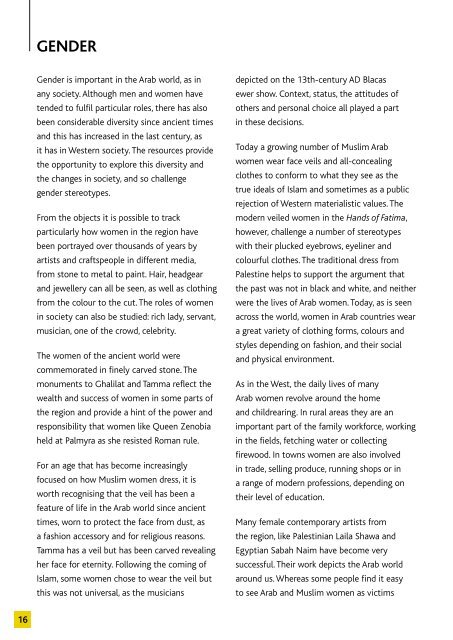Create successful ePaper yourself
Turn your PDF publications into a flip-book with our unique Google optimized e-Paper software.
16<br />
GENDER<br />
Gender is important in the Arab world, as in<br />
any society. Although men and women have<br />
tended to fulfil particular roles, there has also<br />
been considerable diversity since ancient times<br />
and this has increased in the last century, as<br />
it has in Western society. The resources provide<br />
the opportunity to explore this diversity and<br />
the changes in society, and so challenge<br />
gender stereotypes.<br />
From the objects it is possible to track<br />
particularly how women in the region have<br />
been portrayed over thousands of years by<br />
artists and craftspeople in different media,<br />
from stone to metal to paint. Hair, headgear<br />
and jewellery can all be seen, as well as clothing<br />
from the colour to the cut. The roles of women<br />
in society can also be studied: rich lady, servant,<br />
musician, one of the crowd, celebrity.<br />
The women of the ancient world were<br />
commemorated in finely carved stone. The<br />
monuments to Ghalilat and Tamma reflect the<br />
wealth and success of women in some parts of<br />
the region and provide a hint of the power and<br />
responsibility that women like Queen Zenobia<br />
held at Palmyra as she resisted Roman rule.<br />
For an age that has become increasingly<br />
focused on how Muslim women dress, it is<br />
worth recognising that the veil has been a<br />
feature of life in the Arab world since ancient<br />
times, worn to protect the face from dust, as<br />
a fashion accessory and for religious reasons.<br />
Tamma has a veil but has been carved revealing<br />
her face for eternity. Following the coming of<br />
Islam, some women chose to wear the veil but<br />
this was not universal, as the musicians<br />
depicted on the 13th-century AD Blacas<br />
ewer show. Context, status, the attitudes of<br />
others and personal choice all played a part<br />
in these decisions.<br />
Today a growing number of Muslim Arab<br />
women wear face veils and all-concealing<br />
clothes to conform to what they see as the<br />
true ideals of Islam and sometimes as a public<br />
rejection of Western materialistic values. The<br />
modern veiled women in the Hands of Fatima,<br />
however, challenge a number of stereotypes<br />
with their plucked eyebrows, eyeliner and<br />
colourful clothes. The traditional dress from<br />
Palestine helps to support the argument that<br />
the past was not in black and white, and neither<br />
were the lives of Arab women. Today, as is seen<br />
across the world, women in Arab countries wear<br />
a great variety of clothing forms, colours and<br />
styles depending on fashion, and their social<br />
and physical environment.<br />
As in the West, the daily lives of many<br />
Arab women revolve around the home<br />
and childrearing. In rural areas they are an<br />
important part of the family workforce, working<br />
in the fields, fetching water or collecting<br />
firewood. In towns women are also involved<br />
in trade, selling produce, running shops or in<br />
a range of modern professions, depending on<br />
their level of education.<br />
Many female contemporary artists from<br />
the region, like Palestinian Laila Shawa and<br />
Egyptian Sabah Naim have become very<br />
successful. Their work depicts the Arab world<br />
around us. Whereas some people find it easy<br />
to see Arab and Muslim women as victims<br />
with no autonomy and no prospects, Chant<br />
Avedissian’s work depicts one of the most<br />
internationally successful and iconic Arab<br />
people of modern times, the Egyptian singer<br />
Umm Kulthum.<br />
Chant Avedissian, Umm Kulthum. Print on paper. Egypt, AD 1990s.<br />
© Chant Avedissian.<br />
Laila Shawa, Hands of Fatima. Oil and acrylic on canvas.<br />
Palestinian Territories/UK, AD 1989. © Laila Shawa.<br />
ACTIVITIES ON GENDER<br />
CARD NUMBERS: 9, 20, 21, 22, 23, 24, 25<br />
See page 22 for Themes Matrix.<br />
1. Display part of the image on card 9.<br />
Ask the students to suggest who and what<br />
it depicts and where it is and what you might<br />
see outside the frame. Once they have fed<br />
back reveal the whole image and explore<br />
the reactions of the class.<br />
2. Brainstorm with the students on<br />
impressions of Arab men and women.<br />
3. Divide the class into groups and distribute<br />
the cards. Ask them to discuss the objects<br />
and see if their impressions are reinforced or<br />
challenged by this evidence.<br />
4. Identify the diversity in the way that<br />
women are depicted in art. Highlight that<br />
this diversity represents the reality of life for<br />
women over time in the Arab world.<br />
5. If the students were to interview the<br />
women depicted in the pictures what<br />
questions would they ask to find out about<br />
their lives? To do this, you could allocate each<br />
group or student a card and ask them to think<br />
about daily life, clothes, religion and attitudes.<br />
They could do further research to support<br />
their work. This activity could be developed<br />
into some drama work or a magazine article.<br />
17

















